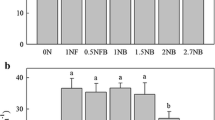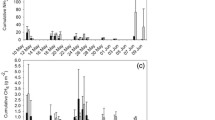Abstract
With the booming development of biogas industry to treat organic waste in China, the by-product of biogas slurry was accompanied with a huge amount. Static storage process of biogas slurry was normally operated under different seasons before application to land which would cause nutrition decomposition and greenhouse gas emission. Thus, the aim of this study was to investigate the nutrition decomposition, greenhouse gas emission (CH4 and N2O), and phytotoxicity of biogas slurry under different static temperatures, furthermore to illuminate the network among them and functional microorganism. According to the results, higher temperature at 30 °C contributed to fast and complete degradation of COD. In addition, more quantity of NH4+ conversion and NO3− formation appeared at 30 °C. These factors resulted in relatively less crop toxicity together. CH4 was the dominant greenhouse gas emission than N2O and was highest in 30 °C treatment with total emission of 273.7 L/(m3·d) and greenhouse gas emission of 20.01 kg CO2e (carbon dioxide equivalent). Lower temperature was conductive to N reservation and reduction of greenhouse gas emission, but making against with stabilization of organic matter and crop safety. At the same dilution times (≤3) of biogas slurry with deionized water, higher temperature at 30 °C could reduce 30 days of storage time, but 10 °C was still unsafe for crop. Structural equation model was further illustrated the positive effect of temperature on NO3−, CH4, GI, and N2O and negative on COD and NH4+. These results could help to monitor the environmental risk, evaluate the maturity, guide the irrigation scheme, and regulate the static storage condition of biogas slurry under different seasons.






Similar content being viewed by others
Data availability
Not applicable.
References
Aihemaiti A, Jiang J, Blaney L, Zou Q, Gao Y, Meng Y, Yang M, Xu Y (2019) The detoxification effect of liquid digestate on vanadium toxicity to seed germination and seedling growth of dog’s tail grass. J. Hazard. Mater 369:456–464
Aita C, Schirmann J, Pujol SB, Giacomini SJ, Rochette P, Angers DA, Chantigny MH, Gonzatto R, Giacomini DA, Doneda A (2015) Reducing nitrous oxide emissions from a maize-wheat sequence by decreasing soil nitrate concentration: effects of split application of pig slurry and dicyandiamide. Eur. J. Soil Sci 66(2):359–368
Bi S, Hong X, Yang H, Yu X, Fang S, Bai Y, Liu J, Gao Y, Yan L, Wang W, Wang Y (2020) Effect of hydraulic retention time on anaerobic co-digestion of cattle manure and food waste. Renew. Energ 150:213–220
Bian X, Wu W, Yang L, Lv L, Wang Q, Li Y, Ye J, Fang D, Wu J, Jiang X, Shi D, Li L (2019) Administration of Akkermansia muciniphila ameliorates dextran sulfate sodium-induced ulcerative colitis in mice. Front. Microbiol 10:2259
Chang R, Guo Q, Pandey P, Li Y, Chen Q, Sun Y (2021) Pretreatment by composting increased the utilization proportion of pig manure biogas digestate and improved the seedling substrate quality. Waste Manage. 129:47–53
Dev S, Saha S, Kurade MB, Salama E, El-Dalatony MM, Ha G, Chang SW, Jeon B (2019) Perspective on anaerobic digestion for biomethanation in cold environments. Renew Sustain Ener Rev 103:85–95
Duan P, Song Y, Li S, Xiong Z (2019) Responses of N2O production pathways and related functional microbes to temperature across greenhouse vegetable field soils. Geoderma 355:113904
Fey A, Conrad R (2000) Effect of temperature on carbon and electron flow and on the archaeal community in methanogenic rice field soil. Appl. Environ. Microb 66(11):4790
Insam H, Gómez-Brandón M, Ascher J (2015) Manure-based biogas fermentation residues – friend or foe of soil fertility? Soil Biol Biochem 84:1–14
Kupper T, Hani C, Neftel A, Kincaid C, Buhler M, Amon B, VanderZaag A (2020) Ammonia and greenhouse gas emissions from slurry storage - a review. Agr. Ecosyst. Environ 300:106963
Kupper T, Eugster R, Sintermann J, Hani C (2021) Ammonia emissions from an uncovered dairy slurry storage tank over two years: interactions with tank operations and meteorological conditions. Biosyst. Eng. 204:36–49
Liang F, Xu L, Ji L, He Q, Wu L, Yan S (2021) A new approach for biogas slurry disposal by adopting CO2-rich biogas slurry as the flower fertilizer of Spathiphyllum: feasibility, cost and environmental pollution potential. Sci. Total Environ. 770:145333
Liu M, Liu C, Liao W, Xie J, Zhang X, Gao Z (2021) Impact of biochar application on gas emissions from liquid pig manure storage. Sci. Total Environ. 771:145454
Lu J, Xu S (2021) Post-treatment of food waste digestate towards land application: a review. J. Clean. Prod. 303:127033
Meng X, Yuan X, Ren J, Wang X, Zhu W, Cui Z (2017) Methane production and characteristics of the microbial community in a two-stage fixed-bed anaerobic reactor using molasses. Bioresource Technol 241:1050–1059
Meng X, Liu B, Xi C, Luo X, Yuan X, Wang X, Zhu W, Wang H, Cui Z (2018) Effect of pig manure on the chemical composition and microbial diversity during co-composting with spent mushroom substrate and rice husks. Bioresource Technol. 251:22–30
Meng, X., Liu, B., Zhang, H., Wu, J., Yuan, X., Cui, Z., 2019. Co-composting of the biogas residues and spent mushroom substrate: physicochemical properties and maturity assessment. Bioresource Technol, 276(281-287).
Meng X, Yan J, Zuo B, Wang Y, Yuan X, Cui Z (2020) Full-scale of composting process of biogas residues from corn stover anaerobic digestion: physical-chemical, biology parameters and maturity indexes during whole process. Bioresource Technol 302:122742
Nag R, Whyte P, Markey BK, O'Flaherty V, Bolton D, Fenton O, Richards KG, Cummins E (2020) Ranking hazards pertaining to human health concerns from land application of anaerobic digestate. Sci. Total Environ 710:136297
Nicholson F, Bhogal A, Cardenas L, Chadwick D, Misselbrook T, Rollett A, Taylor M, Thorman R, Williams J (2017) Nitrogen losses to the environment following food-based digestate and compost applications to agricultural land. Environ. Pollut 228:504–516
Nkoa R (2014) Agricultural benefits and environmental risks of soil fertilization with anaerobic digestates: a review. Agron. Sustain. Dev 34(2):473–492
Pereira J, Misselbrook TH, Chadwick DR, Coutinho J, Trindade H (2012) Effects of temperature and dairy cattle excreta characteristics on potential ammonia and greenhouse gas emissions from housing: a laboratory study. Biosyst. Eng 112(2):138–150
Petersen SO, Dorno N, Lindholst S, Feilberg A, Eriksen J (2013) Emissions of CH4, N2O, NH3 and odorants from pig slurry during winter and summer storage. Nutr. Cycl. Agroecosys 95(1):103–113
Ren T, Yu X, Liao J, Du Y, Zhu Y, Jin L, Wang B, Xu H, Xiao W, Chen HYH, Jin F, Ruan H (2020) Application of biogas slurry rather than biochar increases soil microbial functional gene signal intensity and diversity in a poplar plantation. Soil Biol Biochem 146:107825
Roots P, Wang Y, Rosenthal AF, Griffin JS, Sabba F, Petrovich M, Yang F, Kozak JA, Zhang H, Wells GF (2019) Comammox Nitrospira are the dominant ammonia oxidizers in a mainstream low dissolved oxygen nitrification reactor. Water Res (Oxford) 157:396–405
Singla A, Inubushi K (2014) Effect of biogas digested liquid on CH4 and N2O flux in paddy ecosystem. J. Integr. Agr 13(3):635–640
Slepetiene A, Volungevicius J, Jurgutis L, Liaudanskiene I, Amaleviciute-Volunge K, Slepetys J, Ceseviciene J (2020) The potential of digestate as a biofertilizer in eroded soils of Lithuania. Waste Manage 102:441–451
Sommer SG, Petersen SO, Sorensen P, Poulsen HD, Moller HB (2007) Methane and carbon dioxide emissions and nitrogen turnover during liquid manure storage. Nutr. Cycl. Agroecosys 78(1):27–36
Song S, Lim JW, Lee JTE, Cheong JC, Hoy SH, Hu Q, Tan JKN, Chiam Z, Arora S, Lum TQH, Lim EY, Wang C, Tan HTW, Tong YW (2021) Food-waste anaerobic digestate as a fertilizer: the agronomic properties of untreated digestate and biochar-filtered digestate residue. Waste Manage 136:143–152
Świątczak P, Cydzik-Kwiatkowska A, Zielińska M (2019) Treatment of the liquid phase of digestate from a biogas plant for water reuse. Bioresource Technol 276:226–235
Torrisi B, Allegra M, Amenta M, Gentile F, Rapisarda P, Fabroni S, Ferlito F (2021) Physico-chemical and multielemental traits of anaerobic digestate from Mediterranean agro-industrial wastes and assessment as fertiliser for citrus nurseries. Waste Manage 131:201–213
Urra J, Alkorta I, Mijangos I, Garbisu C (2020) Commercial and farm fermented liquid organic amendments to improve soil quality and lettuce yield. J. Environ. Manage 264:110422
Vergote TLI, Bodé S, De Dobbelaere AEJ, Buysse J, Meers E, Volcke EIP (2020) Monitoring methane and nitrous oxide emissions from digestate storage following manure mono-digestion. Biosyst. Eng 196:159–171
Wang Y, Dong H, Zhu Z, Liu C, Xin H (2014) Comparison of air emissions from raw liquid pig manure and biogas digester effluent storages. T. Asabe 57(2):635–645
Wang Y, Dong H, Zhu Z, Li L, Zhou T, Jiang B, Xin H (2016) CH4, NH3, N2O and NO emissions from stored biogas digester effluent of pig manure at different temperatures. Agri, Ecos Environ 217:1–12
Wang Y, Dong H, Zhu Z, Gerber PJ, Xin H, Smith P, Opio C, Steinfeld H, Chadwick D (2017) Mitigating greenhouse gas and ammonia emissions from swine manure management: a system analysis. Environ. Sci. Technol 51(8):4503–4511
Wang W, Zhang Y, Liu Y, Jiang N, Zhao Q, Deng L (2021b) Managing liquid digestate to support the sustainable biogas industry in China: maximizing biogas-linked agro-ecosystem balance. Gcb. Bioenergy 13(6):880–892
Wang Y, Zhu Z, Li X, Yang J, Liang L, Sui Q, Wang B, Dong H (2021c) NH3, N2O, and NO emissions from digested pig slurry stored under different temperatures: characteristics and microbial mechanisms. J. Clean. Prod 319:128560
Wang Z, Liu T, Duan H, Song Y, Lu X, Hu S, Yuan Z, Batstone D, Zheng M (2021a) Post-treatment options for anaerobically digested sludge: current status and future prospect. Water Res 205:117665
Wang G, Yang Y, Kong Y, Ma R, Yuan J, Li G (2022) Key factors affecting seed germination in phytotoxicity tests during sheep manure composting with carbon additives. J. Hazard. Mater 421:126809
Wu L, Higashimori A, Qin Y, Hojo T, Kubota K, Li Y (2016) Comparison of hyper-thermophilic–mesophilic two-stage with single-stage mesophilic anaerobic digestion of waste activated sludge: process performance and microbial community analysis. Chem. Eng. J 290:290–301
Zilio M, Orzi V, Chiodini M, Riva C, Acutis M, Boccasile G, Adani F (2020) Evaluation of ammonia and odour emissions from animal slurry and digestate storage in the Po Valley (Italy). Waste Manage 103:296–304
Funding
This study was supported by the Open Research Fund Program of Key Laboratory of Cleaner Production and Integrated Resource Utilization of China National Light Industry (Grant number: CP2021YB08) and Key Laboratory of Fertilization from Agricultural Wastes, Ministry of Agriculture and Rural Affairs (Grant number: KLFAW202101) and the National Key Research and Development Program of China (Grant number: 2019YFC1906303) and the National Key Research and Development Program of China (Grant number: 2019YFC1906004) and Research Foundation for Youth Scholars of Beijing Technology and Business University, China, (PXM2020_014213_000017, QNJJ2020-15).
Author information
Authors and Affiliations
Contributions
Xingyao Meng: data curation, roles/writing—original draft preparation, completion of all the experiments, and writing—reviewing and editing. Mingcheng Zhu: roles/writing—original draft preparation, model analysis, and writing—reviewing and editing. Yafan Cai: funding acquisition. Qingping Wang: data curation and resources. Wei Liu: funding acquisition. Lianhai Ren: funding acquisition, data curation, and supervision.
Corresponding author
Ethics declarations
Ethical approval
This research did not involve any human participants and/or animals.
Consent to participate
Not applicable.
Consent for publication
Not applicable.
Competing interests
The authors declare no competing interests.
Additional information
Responsible Editor: Philippe Garrigues
Publisher’s note
Springer Nature remains neutral with regard to jurisdictional claims in published maps and institutional affiliations.
Rights and permissions
Springer Nature or its licensor (e.g. a society or other partner) holds exclusive rights to this article under a publishing agreement with the author(s) or other rightsholder(s); author self-archiving of the accepted manuscript version of this article is solely governed by the terms of such publishing agreement and applicable law.
About this article
Cite this article
Meng, X., Zhu, M., Cai, Y. et al. The greenhouse gas emission potential and phytotoxicity of biogas slurry in static storage under different temperatures. Environ Sci Pollut Res 30, 46257–46269 (2023). https://doi.org/10.1007/s11356-023-25645-x
Received:
Accepted:
Published:
Issue Date:
DOI: https://doi.org/10.1007/s11356-023-25645-x




